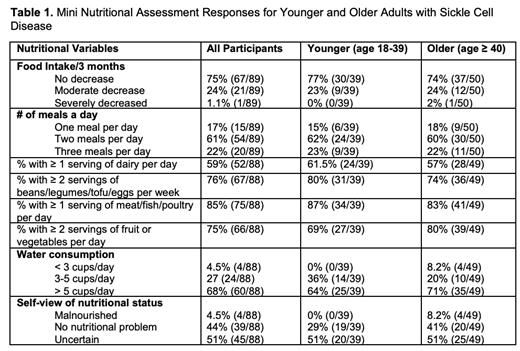Introduction
Sickle Cell Disease (SCD) is a genetic disorder that causes recurrent vaso-occlusive pain events, functional impairment, and nutritional deficiencies due to increased metabolic demands. Prior studies have highlighted nutritional issues in people with SCD, such as micronutrient and macronutrient deficiencies, low body mass index (BMI), and a recent rise in obese adults with SCD. In older adults in the general population, evaluation and management of nutritional status is essential since malnutrition can weaken the immune system and increase the risk of hospitalization and death. Despite the importance of nutrition, little is known about the best way to evaluate nutritional status in older adults with SCD. To identify a relevant yet efficient method to evaluate nutritional status, we conducted content elicitation interviews to describe how younger and older adults conceptualized nutrition. Based on the content of the interviews, we piloted a brief nutritional survey called the Mini Nutritional Assessment (MNA); a common nutritional measure in geriatric assessments.
Methods
As standard practice for concept elicitation, we conducted semi-structured interviews with adults SCD in 4 separate focus groups: two groups of young adults age 18-39 and two groups of older adults age ≥ 40 years. Participants were asked about their perception of the construct of nutrition as part of a longer concept elicitation interview assessing the content validity of the Sickle Cell Disease Functional Assessment (SCD-FA), which is the geriatric assessment for adults with SCD.
After focus group transcripts were analyzed using rapid qualitative analysis, we administered the MNA to a separate cohort of adults with SCD, since its content on macronutrients and hydration was consistent with how adults with SCD conceptualized nutrition.
The scores on the 6-item MNA-Short Form (MNA-SF) range from 0 to 14 with higher scores indicating better nutritional status. Scores 12-14 indicate a normal nutritional status, 8-11 indicate at risk for malnutrition, and 0-7 indicate a malnourished state.
Results
The 4 focus group interviews included 6 younger adults (age 18-39) and 8 older adults (age ≥ 40 years) with SCD. Participants were 57% females and 79% had severe SCD genotype (HbSS or HbSβnull-thalassemia).
In the focus groups, participants described a healthy diet as one that included the major food groups, which were generally defined as protein, fruits and vegetables, and starches/carbs. The majority discussed the importance of adequate hydration to reduce the risk of pain crises. Additionally, participants reported trying to substitute water for soda, juice, and caffeine containing beverages. Many participants stated that a healthy diet involved limited processed foods and sugars. Despite knowledge of the characteristics of a “healthy” diet, some participants expressed difficulty maintaining this diet.
Based on these qualitative results, we selected the MNA to evaluate nutrition since it included items on hydration and assessed intake of various food groups as described by focus group participants. We administered the MNA-SF to a cohort of 88 adults with SCD and 81 had complete data to score the MNA-SF.
The mean score for the MNA-SF for all participants was 11.7 ± 1.8 (younger adults 11.6 ± 1.9 and older adults 11.9 ± 1.8; p= 0.44). The MNA-SF identified 40% (n=34) as being at risk of malnutrition [36% of older adults and 46% younger adults]. Two participants were identified as being malnourished (1 younger and 1 older adult). On remaining MNA items (Table 1), 25% of participants reported decreased food intake with 17% having only 1 meal/day. Most participants (85%) consumed ≥ 1 serving of protein/day and 75% had ≥ 2 servings of fruits or vegetables/day. Most participants (68%) drank > 5 cups of water/day. Results were similar for younger and older adults with SCD.
Conclusion
Data from the focus group interviews revealed that BMI and unintentional weight loss measures alone did not comprehensively capture how people with SCD perceived the concept of nutrition. Incorporating the MNA-SF enhanced measurement of the nutritional domain in the SCD-FA by capturing data on food intake and hydration. In future studies we will assess the construct validity of the full MNA in a larger sample to identify older adults with SCD who would benefit most from nutritional interventions.
Disclosures
Strouse:Agios, Takeda, Disc Medicine: Consultancy, Research Funding.


This feature is available to Subscribers Only
Sign In or Create an Account Close Modal